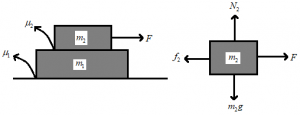Friction Acting on Multiple Surfaces
1. If Force Applied on Lower Block: The maximum friction acting on m₂ is f₂ = µ₂m₂g. If the system moves with the common acceleration, then

F – µ₁ (m₁ + m₂) g = (m₁ + m₂) a and f₂ = m₂a
Maximum acceleration of m₂,
µ₂m₂g = m₂ amax
∴ amax = µ₂g.
2. If Force Applied on Upper Block:
f₂ = Limiting friction between m₁ and m₂.
f₁ = Limiting friction between the surface and m₁.

If F > f₂, then both block move with different acceleration and the maximum friction acts between the blocks.
F – f₂ = m₂a₂.

F – µ₂m₂g = m₂a₂ and N₂ = m₂g
N₁ = N₂ + m₁g = (m₁ + m₂) g
∴ f₁ = µ₁N₁ = µ₁ (m₁ + m₂) g and f₂ = µ₂m₂g
If f₂ < f₁ then m₁ remains at rest. If f₂ > f₁, then m₁ moves in the direction of f₂.
f₂ – f₁ = m₁ a₁.
If F < f₂ then no slipping is found between m₁ and m₂, i.e. m₁ and m₂ move together.
If F < f₁ then the system is in rest. If F > f₁, then the system moves with the common acceleration. In this case:
F – f₁ = (m₁ + m₂) g
F – µ₁ (m₁ + m₂) g = (m₁ + m₂) a.
